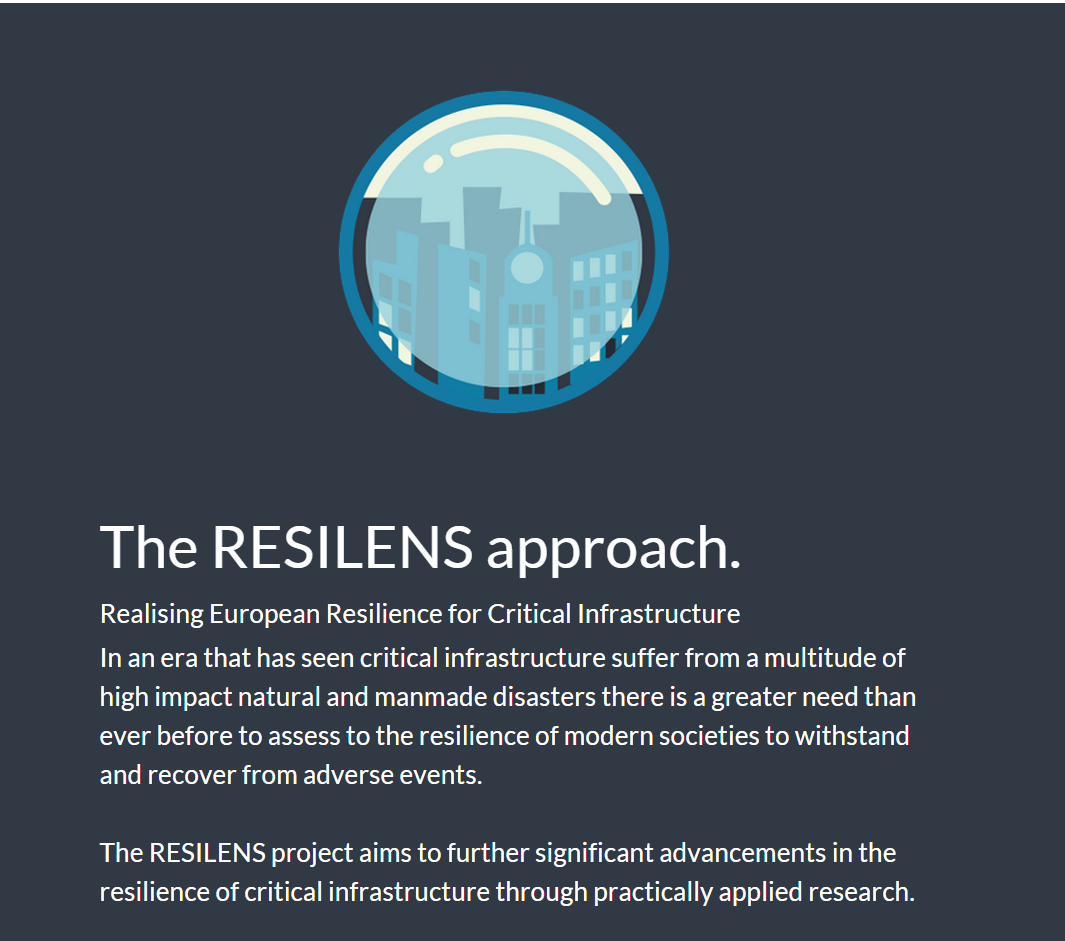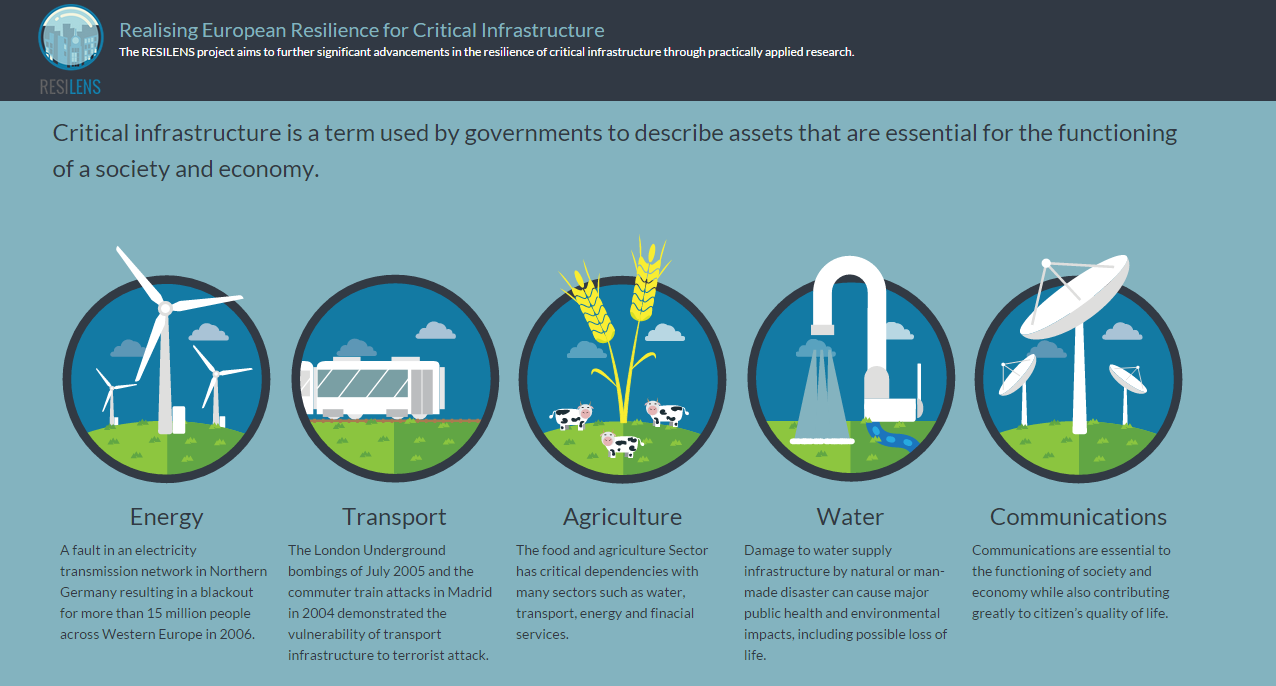-
RESILENS News
RESILENS Workshop – 8th Meeting of the European Commission ‘Community of Users’ on Secure, Safe and Resilient Societies, Brussels – 02/10/2017
EMRA WP4 Pilot Demonstrations Concluding – 12/07/2017
As a RESILENS partner, EMRA has been responsible for leading Work Package 4 (WP4) of the project which we have recently completed with the submission of our WP4 final deliverable report.
RESILENS GA Meeting London – 07/06/2017
Lisbon Pilot Demonstration WS – 06/04/2017
RESILENS GA Meeting Dublin – 02/03/2017
-
Newsletters
-
What is RESILENS?
Realising European ReSILiencE for Critical INfraStructure
Resilience refers to the ability of a system to return to a normal state or ‘business as usual’ following a disruption. As both natural and man-made disaster and crises situations become more common place, there is a greater need than ever before for society to withstand and recover from unexpected adverse events.
Moving resilience from a conceptual understanding to applied, operational measures that integrate best practice from the related realm of risk management and vulnerability assessment is the focus of the RESILENS project.
Key outputs to be developed as part of the RESILENS project are the European Resilience Management Guideline (ERMG) and the Resilience Management Matrix and Audit Toolkit (ReMMAT). The ERMG will support the practical application of resilience to all Critical Infrastructure (CI) sectors, while the ReMMAT will enable CI systems (encompassing organisations and assets) to have their level of resilience indexed. Both, along with accompanying resilience tools, will be hosted on an interactive web based platform – the RESILENS Decision Support Platform (RES-DSP). This will also host an e-learning hub providing further guidance and training on CI resilience.
-
What is CRITICAL INFRASTRUCTURE?
Critical Infrastructure
“Systems and assets, whether physical or virtual, providing essential functions and services to Member States, whose incapacitation or destruction would have a debilitating impact on security, national economic security, national public health or safety, or any combination of these.”
Resilience
“Resilience is the ability of a system or systems to survive and thrive in the face of a complex, uncertain and ever-changing future. It is a way of thinking about both short-term cycles and long-term trends: minimizing disruptions in the face of shocks and stresses, recovering rapidly when they do occur, and adapting steadily to become better able to thrive as conditions continue to change. Within the context of CI, the resilience process offers a cyclical, proactive and holistic extension of risk management practices.”
Critical Infrastructure Resilience
“A transformative, cyclical process, building capacities in technical, social and organisational resources, so as to mitigate as far as possible impacts of disruptive events, based upon new forms of risk management, adaptability and the assessment of potential trade-offs between parts of a system.”
-
Explaining Horizon 2020
Horizon 2020 is the eighth phase of the EU Framework Programme for Research and Technological Development. The programme runs over the period 2014–2020 and provides approximately €80 billion of funding. Horizon 2020 consists of three main research areas; Excellent Science, Industrial Leadership and Societal Challenges.
-
Role of EMRA
The central role of EMRA is to lead RESILENS Work Package 4 – Pilot Demonstrations. The purpose of the Pilot Demonstrations is to operationalise, evaluate and validate the draft guidance and tools which are under development. The testing and evaluation is achieved through a series of Pilot Demonstrations with the project’s CI partners. The Pilot Demonstrations are carried out in as close to real world conditions as possible across the energy, water and transport sectors at varying geographical scales. EMRA’s role as lead partner of this component of RESILENS is to plan and manage the pilot demonstrations, design appropriate evaluation methodology, collate, evaluate and report the results and conclusions. The aim of the Pilot Demonstrations is to enhance resilience management and coordination at national, transboundary, regional, sectoral, societal and organisational levels and to transpose the principles and lessons learned from the Pilot Demonstrations to the ERMG (European Resilience Management Guideline), with a view to enhancing its operability for all end users.
The outcomes from the testing process will be enhanced concepts in resilience and risk management. The integration of the resilience concept into future planning will allow the region to strategically anticipate and plan for crises and disaster in terms of its critical infrastructure including urban and rural space. -
Resilence in Ireland
The concept of resilience is relatively underdeveloped in Ireland. It is envisioned that this project will help integrate resilience as a facilitating concept into strategic planning policy and act as a conduit for enhanced cooperation between the key infrastructure providers/custodians and regional stakeholders. European Resilience Management Guidelines will be produced which aim to provide clear and effective crises and disasters management for critical infrastructure. RESILENS will contribute to understanding through transferring and transforming knowledge and outcomes into strategic measures which will facilitate the integration of the concept and practice of resilience into strategic planning for critical infrastructure development.
-
Contacts – Links
Click here to go to the official RESILENS website.
Connect with RESILENS on Twitter and LinkedIn:



















